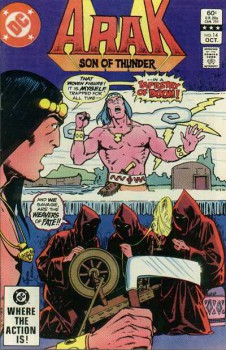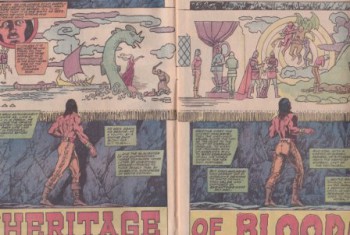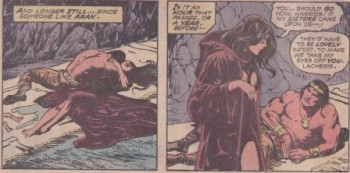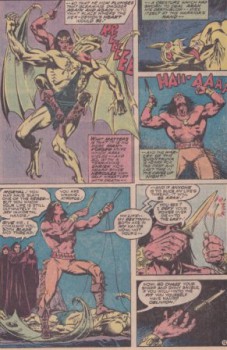Blogging Arak 14: Arak Has a Fling with Fate (Literally)
 Satyricus is offstage sleeping for most of this issue, so we don’t get any comic-relief banter between that randy old goat and Arak. That’s as it should be, though, because this episode delivers a private and transformative event in Arak’s life. This is the issue where Arak comes into his own as a character. (Also, he scores — with one of the Fates, no less! ––which would have been awkward with a satyr on hand.)
Satyricus is offstage sleeping for most of this issue, so we don’t get any comic-relief banter between that randy old goat and Arak. That’s as it should be, though, because this episode delivers a private and transformative event in Arak’s life. This is the issue where Arak comes into his own as a character. (Also, he scores — with one of the Fates, no less! ––which would have been awkward with a satyr on hand.)
Up until now, Arak has been a confused man lacking in self-identity. His tribe was wiped out when he was a boy. He was raised into adulthood by Vikings. Now he wanders in a land where everyone calls him a heathen “red devil.” As he interacts with more “civilized” people, he often displays a stronger innate core of morality and honor than those around him — ironically, and despite his Viking past. He is intelligent, resourceful, but quick to anger when he has been wronged or when he sees someone else wronged (the latter point making him more of a traditional hero than many of his anti-hero barbarian counterparts in fiction).
He is a man who is searching, on an existential quest about the very nature of the universe and his place in it. You see, he assumes his people’s god He-No died with his people, but he was always told he was the son of He-No — the son of Thunder. He has learned in his journeys that there are other thunder gods: Thor, Zeus, Jupiter, and the Christian deity who is said to be the god and maker of everything. Are all these thunder gods but names for one god, he wonders — and, if so, is he somehow a son to all of them? This haunting question has been further compounded by earlier events: his defeat of the sea serpent (back in issue 1) by stabbing it with a heavy metal cross that was subsequently struck by lightning. (Was it the god of the cross or his own father of the thunder who intervened?) Finding his own face carved next to that of Hercules, a Greek hero of old, atop Mount Olympus, only to witness the stone faces cleaved in two by a bolt of lightning. And now, he has discovered a tapestry portraying his life up until now, hung deep in the caves that honeycomb Mount Athos.
Answers to some of these questions will be given in the pages of this issue…
 Arak follows the tapestry, marveling at its portrayal of key events in his young life (and neatly giving readers a recap of important developments from the prior 13 issues — reminding us of the sorceress Angelica, who is clearly to be Arak’s main nemesis, though she has not been seen in several issues, and of the kidnapping of Malagigi by demons and the kidnapping of Valda by Byzantines, and of the death of Khiron the centaur, whose role of mentor was cut short, paving the way for the substitute mentor Satyricus).
Arak follows the tapestry, marveling at its portrayal of key events in his young life (and neatly giving readers a recap of important developments from the prior 13 issues — reminding us of the sorceress Angelica, who is clearly to be Arak’s main nemesis, though she has not been seen in several issues, and of the kidnapping of Malagigi by demons and the kidnapping of Valda by Byzantines, and of the death of Khiron the centaur, whose role of mentor was cut short, paving the way for the substitute mentor Satyricus).
In a clever touch, when he comes to the present moment in the tapestry, he sees an image of himself looking at a tapestry image of himself looking at a tapestry image and so on — the mirror reflection infinity effect.
The unused thread trails off to…the hands of the weaver, of course. She turns out to be a hottie — one of the three “devils in woman’s form” that the monks have been spotting down here in the caverns, doing lascivious things like bathing naked in private. She is Lachesis, the middle sister of the Three Fates. She explains to Arak how her sister Clotho “spins the thread which is a man’s life,” then gives it to her to “weave and measure the thread of life into a tapestry.” The third sister, Atropos, cuts the thread with her golden blade “in due course.”
The whole thing, well, it pisses Arak off. He rips the tapestry from the wall, declaring, “I weave my own destiny — and it’s not hung up for any passing fool to see!”
Now, Lachesis did mention in her explanation that had any other man come there, he would have seen his own life’s tapestry, but under the strange circumstances I’ll give Arak a pass on that oversight. I couldn’t help but be reminded, though, of a much more hapless barbarian: Mark Evanier and Sergio Aragonés’ Groo the Wanderer, one of whose recurring catchphrases is “I can plainly see that!” after someone has just said “as any fool can plainly see.” (Since Arak would be the only “passing fool” who could see his tapestry, he just called himself a fool! But I won’t carry the echo of Groo any further — Arak really is more intelligent and quick-witted than most of the barbarians Evanier and Aragonés were spoofing).
Arak’s broader assertion here, though, is one we can well root for: he is taking a stand against predestination. He is fighting for free will. And to show that this is a fight that can really pay off, he then gets lucky…
 Turns out it’s been a long time since a man came along to visit (well, not counting those monks who occasionally stumble upon the sisters bathing, then immediately run off in frantic terror and poke their own eyes out). Ah, it’s been a while since we’ve had a female character swooning over Arak! Used to happen all the time in the early issues, but then for a while the only female around was Valda — who seems immune to Arak’s masculine charms — and for a few issues now even she’s been absent.
Turns out it’s been a long time since a man came along to visit (well, not counting those monks who occasionally stumble upon the sisters bathing, then immediately run off in frantic terror and poke their own eyes out). Ah, it’s been a while since we’ve had a female character swooning over Arak! Used to happen all the time in the early issues, but then for a while the only female around was Valda — who seems immune to Arak’s masculine charms — and for a few issues now even she’s been absent.
But Lachesis gets Araknified! “Don’t you understand yet?” she asks, caressing his cheek, “I am no mortal woman; I am Lachesis. Yet, I find you bold — and fair to look upon — and it has been long since a real man entered the Caverns of the Fates!”
And then she’s locking lips with him. And as Fate would have it, they get down to some weaving of their own (and I wonder if she will have to go now and weave this little tryst into the tapestry?).
Two panels later, the narrative is asking, “Is it an hour that passes, or a year . . . ?”
I can’t help but notice that Arak still has his pants on. Yes, post-coitus, when Lachesis is slipping her robe back over her naked form, Arak is still wearing his buckskins and boots. Female readers may have a valid point of contention here: in a comic that takes any opportunity to get its female characters unclothed, here is Arak. With his pants still on.
Anyway, Lachesis has to get back to her business and she warns Arak of the danger they are in if her sisters should come and find them.
 This reignites the argument about who has control of his destiny, just long enough for the other sisters to show up. Atropos, in particular, is carrying a grudge — as well as Arak’s thread of life and a golden knife that she’s just itching to use. In tow is that Ker — the bat-winged demon with a face only a gargoyle carver could love — who claimed the right to deliver Arak’s death blow last issue.
This reignites the argument about who has control of his destiny, just long enough for the other sisters to show up. Atropos, in particular, is carrying a grudge — as well as Arak’s thread of life and a golden knife that she’s just itching to use. In tow is that Ker — the bat-winged demon with a face only a gargoyle carver could love — who claimed the right to deliver Arak’s death blow last issue.
A three-way debate over Arak’s fate ensues among the sisters, concluding with the agreement that the Ker can try to kill Arak, but if Arak should prevail over the supernatural creature, he will be allowed to live and carry out his destiny.
So, of course, we get a few pages of pure action, with Arak — weaponless — duking it out with the far more powerful underworld creature.
And this is where the hints and foreshadowing that Roy Thomas has been patiently weaving into his storytelling tapestry really start to pay off. It becomes clear that there’s no way Arak can overcome this immortal creature. Atropos decides to end it and is about to cut the thread…
But remember last issue, when Satyricus and Arak first entered the caverns of Mount Athos, it was noted that there was an ominous thunderstorm brewing across the mountain peaks? Suddenly, a bolt of lightning shoots into the cavern through the very rock itself, causing Atropos to drop her golden blade!
When Atropos goes to retrieve it, her sister Lachesis intervenes, and the Fates are fighting! Lachesis gets hold of the blade and tosses it to Arak!
And now Arak has an immortal blade that can actually hurt the Ker! He takes the Ker’s back, wraps his arm around the demon’s sinewy neck, and with his free hand plunges the blade into the creature’s chest again and again!
Arak wins by KO.
AND THEN (Insert portentous music here, because what follows really warrants it)
In a brilliant masterstroke, Arak wrests his life thread from Atropos and proclaims, “My life — my destiny — both are in my hands now, not yours — and if anyone is to slice my life’s thread, it will be Arak!” With the golden blade, he cuts the thread!
Props to Thomas here for a pretty bold piece of storytelling. I did not see this coming and it truly puts Arak on a heroic plane that the series has long hinted at. He encounters the fates and what does he do? First, he sleeps with one of them. For an encore, he cuts the thread of his own tapestry in defiance of being a pawn to destiny!
We already know Lachesis is smitten with him, but this show duly impresses the other sisters as well. Clotho restores the life thread for him: “You cut your own life’s-thread — something it is given to few mortals to do. Thus, you should have — and shall have, from the hand of Clotho — a new thread of life, from this day forward!”
Arak mutters, “By the dead gods!”
This gives Lachesis an opening to explain, “No, Arak — not ‘by the dead gods!’ For gods do not die, but merely lie sleeping till someone believes in them — and they awaken!”
Her further explanation helps him piece together how his father, the god He-No, intervened when Arak called upon him during battle with the sea serpent. Later, He-No cleaved the stone heads on Mount Olympus. Arak speculates, “[This was] to show me his power — even his concern for me — but he would not fully reveal himself until I accepted the fact that I am indeed — the Son of Thunder!”
After having reached this revelation, Arak is philosophical enough to ask the sisters if the various people’s thunder gods are but different names for one god.
Lachesis answers, “They are all the same, Arak — for the spirit of the Lightning is in them all! They are the gods of the Old World — that world which began to fade and lose power, when the new religions sprang up and gained followers.” (Neil Gaiman used this concept to great effect in The Sandman and in his novel American Gods, but I wonder how far back the idea goes?)
Now that he has embraced his true identity, Lachesis does one final thing for Arak: “As a sign that you have indeed found yourself, after full many a year of seeking — you shall henceforth appear like the Quontauka Brave you have truly become!”
She holds her hands up and miraculously gives Arak a haircut.
“By He-No!” Arak exclaims in wonder (which is a little funny, considering that the only apparent change is of hairstyle — I mean, this guy has seen things that would make a magical haircut seem but a cantrip, mere child’s play!).
Arak tells Lachesis he owes her “so very much,” to which she replies, “Give me a life lived as the gods would want, Arak — and you owe me nothing more.” (Reminds me of what Tom Hanks would say years later to Matt Damon.)
With one last kiss, she then urges him to leave, “before I try to keep you here myself.”
So Arak retrieves slumbering Satyricus (poor old goat missed getting to meet the sisters!). Of course, those monks are still waiting for “Brother Theophano” and his slave to return from their mission to exorcise the mountain of naked-lady demons. When they see a horned, goat-legged man and a swarthy barbarian with a mohawk emerge from the caves, they run in abject fright.
“What happened to your hair?” the satyr asks when he notices that Arak has a mohican. Arak says that perhaps he’ll save that story for another day.
MONSTER TALLY: 5 [the Fates — although can you really call them monsters, unless you’re a monk?; Ker; Centaur (in flashback); Sea Serpent (in flashback); Satyr]
Wow! This sounds like an issue I’d really like to read. Guess I’ll have to hit some back bins.
Have to say I really like that panel with the three fates in the background and Arak poised to cut his thread. It has a dramatic and iconic look to it without being self-consciously so.
Thanks for doing these reviews. It’s always a pleasure to see one posted.
Ilene: “Have to say I really like that panel with the three fates in the background and Arak poised to cut his thread. It has a dramatic and iconic look to it without being self-consciously so.”
Alfredo Alcala’s lay-out really impressed me this issue. The angles and stage blocking he chooses are effective in service to the story without drawing undo attention to the artifice.
His penciling and inking are first-rate, too: His people look great, and the details are nicely inked: for instance, the textures of the cave walls in contrast to the tassels of the tapestry. He seems really to have hit his stride this issue.